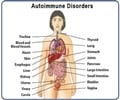- Polymyositis - Adult - (https://medlineplus.gov/ency/article/000428.htm)
- Davidson’s Principles and Practice of Medicine – 21st edition - (http://www.mayoclinic.org/diseases-conditions/polymyositis/basics/definition/con-20020710)
- Polymyositis - (http://www.myositis.org/learn-about-myositis/types-of-myositis/polymyositis)
- Polymyositis and dermatomyositis - (http://www.arthritisresearchuk.org/arthritis-information/conditions/polymyositis-and-dermatomyositis.aspx)
What is Polymyositis?
Polymyositis is a condition in which there is inflammation of muscles resulting in weakness and further complications that can also be life threatening. It usually occurs between 40-60 years of age and is more common in women. It is sometimes associated with certain autoimmune disorders such as systemic lupus erythematosus Sjogren’s syndrome and scleroderma.
Dermatomyositis is condition similar to polymyositis with visible skin involvement. It usually shows perimysium inflammation i.e. inflammation of the outermost layer of the muscle as opposed to endomysium inflammation i.e. inflammation of the innermost layer of the muscle, as is seen in the case of polymyositis. This can even occur in kids between 5-14 yrs.

What are the Types of Myositis?
Myositis can be of varying types
- Primary idiopathic polymyositis – Inflammation of muscles due to unknown cause.
- Primary idiopathic dermatomyositis – Inflammation of muscles with skin manifestations due to unknown cause.
- Polymyositis or dermatomyositis associated with malignancy – Inflammation of muscles with or without skin manifestations due to cancer.
- Childhood polymyositis or dermatomyositis – It is very rare.
- Polymyositis or dermatomyositis associated with another connective-tissue disease
- Inclusion body myositis – Inflammation of muscles showing characteristic features known as inclusion bodies which are protein aggregates present in the muscle.
What are the Causes of Polymyositis?
Polymyositis is an immune-mediated disorder. The cause for polymyositis is not clear.
- There might be a genetic factor involved in development of the disease.
- Certain viruses have also been linked to this disease such as HIV, HTLV-1(Human T Lymphotropic Virus), coxsackie virus and simian retrovirus.
- It can also be a part of paraneoplastic syndrome associated with certain types of cancer such as lung cancer, breast cancer and ovarian cancer.
- Certain drugs are known to be harmful to muscles. These include hydroxychloroquine, colchicine and D-penicillamine. Also statins, a class of drugs which lower blood cholesterol, can have harmful effects on muscles.
What are the Symptoms of Polymyositis?
In polymyositis, progressive weakness occurs in the proximal muscles, i.e. the muscles in upper arm, thigh, neck and other such muscles that are closer to the trunk. Polymyositis affects the lower limbs more than the upper limbs. Symptoms include:
- Morning stiffness
- Neck muscle weakness
- Fever
- Weight loss
- Difficulty in climbing stairs, getting up from sitting position, kneeling, raising arms, combing hair and lifting objects
- Mechanic’s hand – thickening of the skin of the hand
- Associated joint pains – arthralgia
- Difficulty in swallowing
- Difficulty in breathing – during advanced stages
- Foot drop – during advanced stages
- Rash predominantly on the shoulders, chest and back – the shawl region, in dermatomyositis. Other features include scaly erythematous (red) or psoriasiform plaques on the joints of the fingers (inter-phalangeal joints) and violet discoloration of the eyelids with swelling around the eyes.

What are the Complications of Polymyositis?
Complications of polymyositis include the following:
- Interstitial lung disease, where the lungs are affected causing breathlessness
- Aspiration pneumonia. Due to difficulty in swallowing, the contents of the mouth and upper throat may enter the respiratory tract and lungs thereby causing pneumonia
- Calcinosis, where calcium deposits accumulate in the muscles
- Heart-related complications like arrhythmias (irregular heart beat), congestive heart failure, pericarditis (inflammation of the tissue lining the outside of the heart) and heart attack
- Malnutrition, which occurs because of difficulty in swallowing and improper absorption of nutrients from the digestive tract.
- Infection, due to poor immunity.
- Cancer, like the cancer of the breast and lung.
- Complications due to the steroid and other medications.
How is Polymyositis Diagnosed?
Polymyositis is diagnosed based on:
- Blood tests show elevated erythrocyte sedimentation rate (ESR), C-reactive protein and increased white blood cells (leukocytosis), which are all indicative of inflammation. The levels of the enzymes creatine kinase and aldolase are increased, which indicate muscle damage.
- Muscle biopsy shows findings consistent with death and degeneration of muscle tissue and inflammation.
- Electromyography is the testing of muscle’s electrical activity and shows signs of muscle damage in polymyositis.
- Antibody test: Anti-Jo-1 antibodies are detected in the blood in 20% of cases.
- Urine analysis: Myoglobinuria, i.e. excretion of the protein myoglobin derived from muscles in the urine, is present.
- CT scan is used to detect any associated cancers, which could cause polymyositis.
- Magnetic Resonance Imaging (MRI) is used to evaluate the extent of muscle involvement.

How is Polymyositis Treated?
Treatment of polymyositis aims at relieving symptoms since polymyositis usually cannot be totally cured.
- Oral corticosteroids – Prednisolone is used to reduce inflammation
- Immune suppressive therapy – Azathioprine, cyclosporine, cyclophosphamide and methotrexate are used to reduce the autoimmune response
- Intravenous immunoglobulins are used in patients who do not respond to steroids. Other drugs like rituximab, tacrolimus and etanercept have also been tried out
- Physical therapy, speech therapy, a high protein diet and specialized exercise therapy are also given.

Health tips
Eating a high protein diet and regular exercise can improve the quality of life of a patient suffering from polymyositis. Early diagnosis and medical intervention is the key to managing this disease. The condition is unavoidable but a positive attitude and effective healthcare can help such patients lead a satisfactory life.








